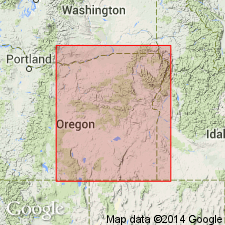
- Usage in publication:
-
- Bernard Formation
- Modifications:
-
- First used
- Dominant lithology:
-
- Conglomerate
- AAPG geologic province:
-
- Blue Mountains province
Summary:
Bernard Formation. Mapped in area of about 40 sq. mi., southwest of John Day in east-central Oregon. Consists of pebbly sandstone and sandy "roundstone" conglomerate; thickness 1,500 feet. Overlies Shaw formation (new) with angular unconformity; underlies Columbia River basalt with angular unconformity. Age is Late Cretaceous.
Source: US geologic names lexicon (USGS Bull. 1350, p. 61); supplemental information from GNU records (USGS DDS-6; Menlo GNULEX).

- Usage in publication:
-
- Bernard Formation
- Modifications:
-
- Original reference
- Biostratigraphic dating
- Dominant lithology:
-
- Sandstone
- Conglomerate
- AAPG geologic province:
-
- Snake River basin
Summary:
Pg. 68-70, pls. 1, 3. Bernard Formation. Yellowish-brown calcareous and limonitic pebbly sandstone that grades locally into sandy "roundstone" conglomerate. The pebbly or cobbly sandstone occurs in massive units as much as 200 feet thick. Total estimated thickness 1,500 feet. Rests with angular unconformity on Paleozoic, Upper Triassic and Middle Jurassic strata and is overlain with angular unconformity by Tertiary lava and tuffs. Occurrence of TURRILITES and PSEUDOUHLIGELLA in lower 500 to 600 feet indicate lower portion is Cenomanian.
Typical strata exposed near Andrew Bernard ranch house, in Smith basin, and north of Camp Creek near Soda Spring. Forms elongate belt approximately 4 sq mi. Name taken from Andrew Bernard Ranch on South Fork of Beaver Creek, northwest of Suplee, in SE/4 sec. 11, T. 17 S., R. 25 E., Grant Co., OR.
Source: US geologic names lexicon (USGS Bull. 1350, p. 61); supplemental information from GNU records (USGS DDS-6; Menlo GNULEX).

- Usage in publication:
-
- Bernard Formation
- Modifications:
-
- Overview
- AAPG geologic province:
-
- Blue Mountains province
Summary:
Pg. 5. Bernard Formation. Defined by Dickinson and Vigrass (1965). Exposed in northwestern part of Suplee-Izee district and is contiguous with the Gable Creek and Hudspeth Formations of Wilkinson and Oles (1968) and Oles and Enlows (1971) in the Mitchell quadrangle. Consists of approximately 1,500 feet of massive, yellow-brown, calcareous and limonitic pebbly sandstone and subordinate interbedded clayey sandstone, poorly consolidated gravel, gray mudstone, and brown shale. Locally, sandstone grades into sandy ["roundstone"] conglomerate containing aphanitic porphyry of intermediate composition, chert, granitic clasts, and metaquartzite. Overlies older Mesozoic units with angular unconformity. Age is [earliest Late Cretaceous] (Cenomanian), based on fossils recovered from the lower 500 to 600 feet.
Source: Publication.
For more information, please contact Nancy Stamm, Geologic Names Committee Secretary.
Asterisk (*) indicates published by U.S. Geological Survey authors.
"No current usage" (†) implies that a name has been abandoned or has fallen into disuse. Former usage and, if known, replacement name given in parentheses ( ).
Slash (/) indicates name conflicts with nomenclatural guidelines (CSN, 1933; ACSN, 1961, 1970; NACSN, 1983, 2005, 2021). May be explained within brackets ([ ]).

